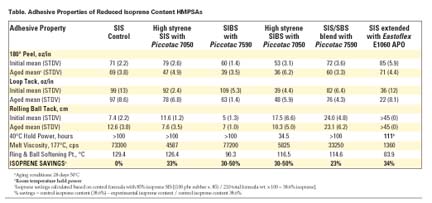
The current shortage of isoprene is having a serious impact on tape and label manufacturers around the world. These manufacturers have traditionally used styrene-isoprene-styrene (SIS) block copolymers in their formulations because SIS-based hot-melt pressure-sensitive adhesive (HMPSA) formulations can be used over a range of temperatures. They also provide an aggressive tack, enabling tailored peel adhesion properties with good cohesive strength. SIS is formulated into adhesives with good color, clarity and low odor.
This article offers several formulation strategies to help tape and label manufacturers mitigate the current isoprene shortage. These strategies will allow PSA manufacturers to continue production of high-quality PSA tapes while reducing isoprene content by as much as 50%. In addition, these approaches produce a quality end product and also create significant production efficiencies, minimize labor requirements, and reduce costs.
High Styrene SIS Copolymers
Using SIS copolymers with high styrene content combined with additional tackifying resins can help improve the efficiency of the isoprene in the polymer. The high styrene content helps the block copolymer to tolerate higher resin loading without sacrificing performance. Only highly aromatic modified hydrocarbon tackifiers with a very low softening point can handle block copolymers with high styrene content. Lab tests performed using EastmanPiccotac7050 hydrocarbon resin reduced isoprene levels by 33% while maintaining proper adhesion and peel strength.The SIBS Solution
Elastomers can also be made using butadiene in place of isoprene. SBS elastomers are difficult to formulate in order to provide the correct balance of tack and cohesion required for PSA tapes and labels. Kraton Polymers LLC has produced a developmental group of elastomers where a portion of the isoprene in SIS elastomers is replaced with butadiene. These new elastomers, called SIBS, require less isoprene than typical SIS elastomers but still provide SIS-like properties to the adhesive.SIBS elastomers exhibit a good balance of hard and soft rubber characteristics, providing a formulation that requires less isoprene. SIBS blends create a diluted, though effective, solution with a lower molecular weight than SBS copolymers. The lower molecular weight of the copolymer reduces the mixing viscosity, generating an efficient process that requires less labor, time and energy. Lab tests showed that SIBS-based PSA formulations performed well, with a 30-50% reduction in isoprene content depending on the formulations under consideration.
Formulating PSAs with SIBS
When using SIBS in place of SIS in a traditional SIS formula, PSAs will require changes to the tackifier resins in the formulation due to the addition of butadiene to the elastomer mid-block. Performance characteristics of resins depend on the compatibility of the polymer used with them. Aromatically modified C5 hydrocarbon resins are recommended here because they are more compatible with SIBS elastomers and offer better tack and peel strength properties than their aliphatic cousins. In fact, aliphatic resins are not compatible with the SIBS polymer, giving very low tack and low adhesion.
Eastman Piccotac 7590 hydrocarbon resin is an excellent tackifier for SIBS. Compatible with a range of natural and synthetic rubbers, 7590 improves tack while maintaining the cohesive strength of the formulation. In addition, these formulations can be coated at lower temperatures and perform well as the adhesive ages. These factors will be important to manufacturers looking to improve worker safety and maintain consistent product performance. Piccotac 7590 resin has light color and low odor, which allows its use in numerous demanding applications.
High-Styrene Formula Extends Isoprene Further
The isoprene in SIBS-based PSAs can be further extended by raising the styrene content of the SIBS blend. As with high-styrene SIS formulations, only highly aromatic modified hydrocarbon tackifiers with a low softening point are recommended. Lab tests conducted using Piccotac 7050 showed an overall reduction of isoprene of 30-50% depending on the PSA tape formulations under consideration.

Blending SBS and SIS
To further extend their existing inventories of isoprene-based polymer, manufacturers can also blend SBS with SIS - though a thorough inquiry of formulation requirements is recommended. Studies at Eastman showed that SIS block copolymers diluted with SBS in conjunction with aromatic-modified, aliphatic hydrocarbon tackifiers permit a reduction of isoprene content of 23% while maintaining peel and tack properties.Extending SIS with APOs
As much as 30% of the SIS in PSA formulations can be replaced with amorphous polyolefins (APOs). APOs offer good compatibility with a variety of polymers and tackifiers, with little impact to clarity, odor, or tack when properly formulated. These blends require the use of hydrogenated hydrocarbon tackifiers to produce reasonable adhesive properties. Eastman's Eastotac hydrocarbon resin tackifiers are ideally suited for this purpose.APOs are available in a range of forms to meet processing needs. Eastman now produces Eastoflex APOs in the form of pourable pellets. This product form provides better heat transfer, rapid dispersion and easier handling due to the large surface-to-volume ratio of the pellets. These properties improve the processibilty of Eastoflex APOs in adhesive formulations.
Manufacturers should check with their APO suppliers for specific recommendations in their PSA formulations. Retrofitting of processing equipment might also be required to allow for
the addition of an additional material in the formulation.
Conclusion
All of the strategies mentioned involve extending the amount of available SIS in PSA formulations by diluting SIS in existing PSA formulations with other commercially available materials. Formulators should recognize that these are starting-point formulations only. Formulations must be further optimized by adjusting the formulations to meet specific customer requirements either by adjusting the proportions of oil and resin or by the introduction of co-tackifiers to develop specific adhesion properties.
About the author
Mark Peters graduated from the University of North Carolina in 1994 with a Ph.D. in organic chemistry. He began his career with Bayer Corp., where he took on various responsibilities from new product development to manufacturing. Peters joined Eastman Chemical Co. in Kingsport, TN, as a Principal Application Scientist for adhesives in 2004. He was named Group Leader, Adhesive Applications Technology, for Eastman in 2005.For more information on the new SIBS elastomers available from Kraton Polymers, contact Kelon Morley, Global Market Development Manager, phone (832) 204-5408 or e-mail kelon.morley@kraton.com.
For more information on Eastman tackifiers, visit http://www.eastman.com/adhesives or contact Mark A. Peters at (800) EASTMAN or e-mail mpeters@eastman.com.
